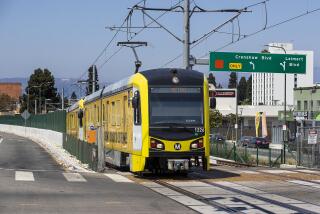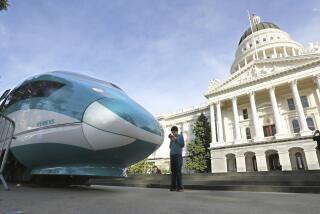Not all of stimulus is according to plan
WASHINGTON — It is a six-mile stretch of guardrail near a manufactured lake in a desolate patch of the Oklahoma Panhandle. There’s little reason for anyone to visit. Weeds are overgrown; the lake bed is virtually dry.
Yet repairing the guardrail is on a list of projects developed by the U.S. Army Corps of Engineers to tap into President Obama’s $787-billion economic stimulus program.
The price tag: more than $1.1 million.
As Obama moves to accelerate the flow of federal stimulus funds, public officials are voicing concerns that some of the projects being devised are of dubious merit.
Obama spoke of the stimulus as a mechanism to create jobs, drop money into a struggling economy and reposition the U.S. as a more energy-efficient nation. So far, those goals are proving difficult to meet.
U.S. Sen. Tom Coburn (R-Okla.) is putting out a report early this week that will raise questions about the validity of certain projects.
By some measures, the stimulus program is working. Aging bridges and roads are being repaired, providing needed jobs for construction workers. Money is going back to working-class Americans in the form of a tax cut.
Yet some projects moving forward aren’t what was envisioned when the stimulus was signed into law Feb. 17.
Obama billed the program not only as a vehicle for new jobs but as seed money for a kind of top-to-bottom transformation. Part of the payoff would be a long-term dividend of new renewable energy sources feeding into “smart” grids that reduce utility costs and rid the atmosphere of dangerous greenhouse gases.
A few days before signing the stimulus bill, Obama said in his weekly radio address that the money would underwrite “the work of building wind turbines and solar panels and the smart grid necessary to transport the clean energy they create; and laying broadband Internet lines to connect rural homes, schools and businesses to the information superhighway.”
Not all of the money is heading toward such purposes. Local governments have their own ideas on how it should be spent. And some are making choices that may be at odds with Obama’s vision.
In Minneapolis, the City Council voted recently to spend $2 million in stimulus funds on a vacant 99-year-old theater that developers want to convert into a center for dance. The project would create about 48 permanent jobs, city documents indicate.
In the competition for the limited stimulus money, the council awarded less than $300,000 to a company that wants to open a solar-energy-panel manufacturing plant that would create 360 jobs by 2011, according to city records.
Because the solar plant didn’t get more funding, its chief executive officer, Joel Cannon, said he wouldn’t be able to open the plant in Minneapolis.
There was one dissenting vote on the council. Councilman Paul Ostrow said the theater wasn’t creating enough jobs to qualify for stimulus money, whereas the solar-energy plant “clearly fit the president’s goals. . . . It was a home run.”
Federal guidelines say that stimulus money may not go toward “recreational facilities that serve a predominantly higher-income clientele.”
An official with Minneapolis’ Shubert Theater, Colin Hamilton, rejected the idea that dance appeals mostly to an affluent audience.
“It’s true that anyone who can afford a $12 ticket has identified himself as slightly above some means,” he said. “But if you look at us against other art forms, dance on affordability basis is one of the most accessible you’ll find in this community.”
Communities get stimulus money largely through automatic formulas, which include such factors as population, or in some cases competitive grants. The federal government reviews applications. Certain projects are banned, including swimming pools, golf courses, zoos, aquariums and casinos.
Demand for stimulus money is intense. And with cities and towns exhorting federal officials to release the money as quickly as possible, some projects may not get adequate vetting.
Vice President Joe Biden conceded as much, saying earlier this month: “There are going to be mistakes made. . . . We know some of this money is going to be wasted.”
In some cases, the stimulus is merely substituting one pot of government money for another.
The Obama administration released a report marking the 100-day anniversary of the stimulus program called, “100 Days, 100 Projects.” One project mentioned was a $2-million award to a contractor to improve sewers in Portland, Maine.
City officials said the aging system was causing raw sewage to seep into the water supply. But the project was going forward in any case.
Had no stimulus funds come available, the city would have obtained a loan from the state. City officials said that because of the stimulus, Portland now has more money available to take on other projects.
Still, the sewer work is “certainly a project that we would have had to complete one way or another,” said Nicole Clegg, director of communications for Portland.
Then there are projects that create work, but seem to fit no long-range plan.
Oklahoma officials were stunned to see the $1.1-million guardrail project offered up by the Army Corps of Engineers as a candidate for stimulus money. With so many other pressing needs, spending money in a desolate area showing no signs of a comeback is indefensible, they said.
“They’re not mowing the weeds, which are 2 or 3 feet tall,” said Ted Graham, city manager in nearby Guymon, Okla. “They quit maintaining the lake in the park, so it would be a frustration if they spend a million dollars on a guardrail they don’t maintain currently.”
A spokesman for the corps said that repairing the guardrail with stimulus money was one of several options under consideration. “The guardrail is deficient, broken and needs repairs,” said Ross Adkins, spokesman for the corps’ Tulsa district.
He conceded that the guardrail is within an area that “has pretty much been abandoned.”
“There’s no water there, no recreation to speak of. There’s nothing there to attract people,” Adkins said.
Coburn and the state’s other U.S. senator, Republican James M. Inhofe, sent a letter to the corps earlier this month objecting to the project.
Given the “serious infrastructure concerns around the nation,” they wrote, “it is difficult to comprehend the decision by your agency.”
Americans may be wondering the same thing, on a broader scale.
A Rasmussen poll last week showed that only 39% believed that stimulus spending would help the economy, compared with 44% who said it wouldn’t.
The poll also showed that 45% of respondents believed the stimulus program should be canceled, compared with 36% who wanted to keep it going.
--
More to Read
Sign up for Essential California
The most important California stories and recommendations in your inbox every morning.
You may occasionally receive promotional content from the Los Angeles Times.










